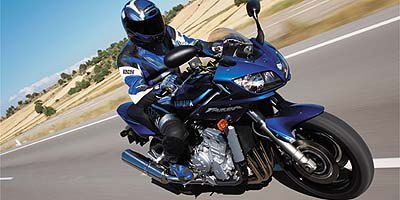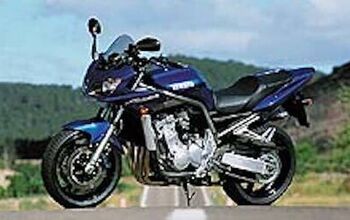2001 Yamaha Fazer 1000 (2) - Motorcycle.com
Torrance, California, September 1, 2000 -- Go ahead and laugh. Make snide remarks about how some engineers in Japan have castrated your beloved R1. They've turned it into this bland and overbearing, upright -- and proportionally uptight -- monster that will soon sit on salesroom floors polluting the very air said R1 must also breathe. Darwin is turning over in his grave, for sure. If this is not dilution of the gene pool, you don't know what is.
Fine, then. Go into the loo and Stridex those pimples away. Run off to school and don't forget your homework or that sack lunch mommy made for you with lo
Wonderful. Now that the kids are gone, we can introduce to you a bike for people who appreciate performance and comfort in a package that is stylish without being garish, edgy without being too mod-architectural in design; Yamaha's new Fazer 1000. Think of it as an R1 for adults, if you will.
According to sources at Yamaha, "everything about this bike is awesome." Of course we expect them to say that, but judging by some of the numbers we've seen, we will not attempt to counter that statement. How does 143 horsepower at the crank with a dry weight of 450 lbs and fully adjustable suspension sound to you? To us, that sounds like about a peak of 122 bhp with a hefty torque curve wrapped in a brand new, tubular steel double cradle frame. In all, probably weighing in at 485 pounds wet. If these numbers hold true, that's about twelve more horsepower and 35 less pounds than Suzuki's Bandit 1200S.
Yamaha acknowledges the fact that there is an aging marketplace that needs to be addressed. These are people who are a long way from walkers and daily pill planners, but who have progressed beyond a Neanderthal-esque racer crouch on bikes with peaky powerbands and acid-trip graphics but still want uncompromising performance. What their engineers came up with is a standard with a hard edge or, as it's being called in Europe, a "Muscle Sport" that's being labeled an "R1 for the real world."
Usually, when a manufacturer takes a class-leading sportbike and tries to make it more "user-friendly" they end up taking the fun out of life. Yamaha says they have gone to great lengths to ensure that this is not the case with the new Fazer. For instance, the motor has all the updates as the Year 2000 R1 and even uses the now-famous EXUP system as well as the eco-friendly AIS (Air Injection System). The chassis sports the same long swingarm trick -- first seen on the R1 and now copied on the new GSX-R750 -- to ensure, Yamaha hopes, the best handling and power in the class.
Yamaha claims that the motor on the Fazer puts out seven fewer horsies at the crank than the R1. That's not a lot, but wInternally, the crank shaft inertia has been increased by 10 percent "to improve around town riding." Additionally, the clutch is a smaller diameter unit than the one employed on the R1, though it uses one extra steel plate and one extra friction plate. The motor is liquid cooled by a radiator that retains the same 340mm width as the R1, but is 50mm shorter at 238mm. This should not cause any overheating concerns, however. As powerful and good-handling as this bike is supposed to be, there's little chance of it having to endure the type of stresses and extremes that a racetrack places on a motor. Like using a meat locker to keep a six-pack cool, sometimes you might be better off with just a styrofoam box -- or a smaller, lighter radiator in this case.
Suspension compentents bolted to that steel chassis have changed to better suit this bike's intended use. Where the Fazer's racier brother has inverted forks, this machine will use 43mm conventional forks sourced from Kayaba, who will also manufacture the piggyback-style rear shock. Both ends of the bike are fully adjustable -- compression, rebound and spring preload can all be tweaked -- with the front axle moving through 140mm of travel while the rear shock moves through 65mm of stroke and works in conjunction with a rising-rate linkage to control the rear wheel.
Slowing things down up front are the same calipers and rotors (four pots squeezing 298mm rotors) as used on the R1. The only difference is in pad material that provides a less aggressive initial bite on the rotors. In the rear, the caliper is the same, but the 267mm rotor is slightly larger than the disc used on the R1 (245 mm on the R1). Our guess is that, even with these less aggressive pads and larger rear rotor, the Fazer should have no problem entertaining even the Rothwell-types among us.
Other nice touches and attention to detail are liberally sprinkled throughout this bike. Behind the fairing is a full set of gauges that include a clock and a much-appreciated fuel gauge -- nice touches on a bike that's sure to see as much sport-touring duty as it will backroad blitzing. The center stand is standard issue as is a five-position adjustable clutch lever. The passenger grab rails look like they're metallic when they are, in fact, a composite resin material that is much lighter.
There's just one caveat, though: Despite so much of the input for this bike coming from the United States, as of right now the Fazer will be available only in Europe. A Yamaha U.S. representative could not confirm or deny any plans to bring this bike over here. Still, we cannot imagine why they would not -- especially when the bike would sell for roughly $8,500 US dollars (which is nearly $2,000 less than an R1 and only $1,000 more than Suzuki's new Bandit 1200S). So all we can do right now is voice our opinion about whether or not this bike should be sold in the good old US of A. And the only pearl of wisdom we can offer you in this matter is the very thing that gets MO what we need when we're standing in the face of adversity: Beg.
Note: Since this story went up, Yamaha U,S, has confirmed that the Fazer will be sold here in the U.S. as the FZ-1 -- Minime
More by MO Staff

































Comments
Join the conversation